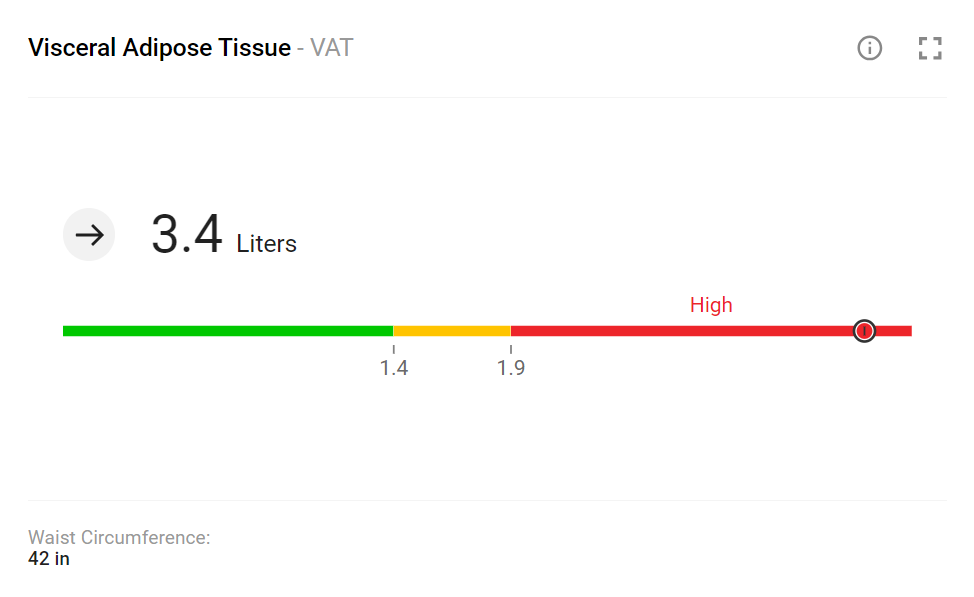Understanding Visceral Adipose Tissue: Key Insights for Health Professionals
As obesity rates continue to rise, the importance of precise body composition analysis becomes increasingly evident.
Visceral adipose tissue (VAT), the fat stored around internal organs, plays a crucial role in understanding and managing obesity-related health risks. In this post, we delve into the significance of VAT, the role of accurate measurements, and the clinical implications for health professionals.
The Importance of Precise Body Composition Analysis
Body composition analysis goes beyond simple weight measurements to provide a comprehensive understanding of the body’s makeup, including muscle, fat, and water. This precision is essential for identifying health risks and tailoring interventions for obesity management.
The Growing Concern of Obesity
The CDC warns that heart disease, stroke, type 2 diabetes, and certain cancers are linked to obesity. Currently, 30-40% of Americans are affected by obesity, and this rate is projected to rise to 50% by 2030. These alarming statistics underscore the need for accurate body composition analysis to combat obesity and its associated health risks.
Understanding Visceral Adipose Tissue
Visceral adipose tissue (VAT) is the fat stored around internal organs such as the liver, pancreas, and intestines. Unlike subcutaneous fat, which is stored under the skin, VAT is located deeper within the abdominal cavity and is closely associated with various metabolic diseases. High levels of VAT are linked to increased risks of type 2 diabetes, cardiovascular diseases, and certain cancers.
The Role of Waist Circumference in VAT Measurement
Bioelectrical impedance analysis (BIA) is a valuable tool for assessing skeletal muscle mass and VAT. However, waist circumference and gender are major predictors of VAT. Accurate waist measurements enhance the predictive value of BIA, leading to more reliable visceral fat estimates. This combination of methods provides a comprehensive view of body composition and helps in identifying health risks more accurately.
Ethnic and Gender Differences in VAT Measurement
Research has shown that the accuracy of BIA equations varies based on ethnicity and gender. Factors such as body shape, muscularity, and fat distribution can influence these measurements. For instance, Asians and Hispanics may show different biases in VAT prediction compared to Caucasians. This highlights the need for correction factors based on precise waist circumference measurements to improve the accuracy of VAT prediction models and allow for individualized assessments.
Clinical Relevance of Accurate VAT Assessment
In clinical settings, precise assessment of VAT and waist circumference is crucial for monitoring and managing obesity and related conditions. These measurements help tailor interventions and track progress, forming an essential part of comprehensive body composition analysis. Understanding the distribution of adipose tissue enables healthcare providers to design effective treatment plans and improve patient outcomes.

Why VAT Matters for Obesity Management
The higher the visceral fat value, the higher the risk of cardiometabolic illnesses. With the Seca mBCA, negative trends can be detected early to initiate corresponding treatments and therapies. The easy and quick assessment of visceral fat is an essential tool for estimating cardiometabolic risk, particularly in overweight and obese patients. The medical fields particularly interested in obtaining visceral fat values include bariatrics, weight management, diabetology, hospital nutrition, cardiology, and general health.
Dr. Angela Fitch, Chief Medical Officer at Knownwell, explains, “The location of adipose tissue in the body is significant for various health considerations. Adipose tissue can be subcutaneous (under the skin) or visceral (around internal organs).” Dr. Fitch goes on to mention, “The distribution of fat matters because individuals who carry more fat in their visceral compartment, around internal organs, are at a higher risk of developing metabolic diseases, including cardiovascular conditions. Subcutaneous fat, while still a health concern, is generally less of a risk factor for metabolic diseases. The optimal range for visceral fat is typically less than one pound, and MRI measures it in liters because it provides a volumetric assessment of fat distribution in the three-dimensional space around internal organs. Understanding the location of adipose tissue helps healthcare professionals assess the individual’s health risks and tailor appropriate interventions accordingly.”
Research Insights on VAT and Health Risks
For an in-depth understanding of the clinical significance of VAT, we recommend reviewing the research article “Clinical Relevance of Accurate VAT Assessment” published in the European Journal of Clinical Nutrition. This study highlights the importance of accurate VAT measurement in predicting health risks and designing effective obesity management strategies.
Further Reading and Resources
To explore more about body composition analysis and its applications in clinical practice, visit our collection of medical studies and research articles.
Accurate measurement of visceral adipose tissue is a cornerstone of effective obesity management and comprehensive health assessment. By understanding and utilizing precise body composition analysis, healthcare professionals can enhance patient care and address the growing challenge of obesity. Stay informed and equipped with the latest research and tools in body composition analysis to make a meaningful impact on your patients’ health.
Recommended Episodes
Episode 53: Peptides, Products & Promises: Cutting Through the Hype
Dr. Nina Crowley sits down with Dr. Jacqueline Jacques to explore peptides, GLP-1s, and the supplement surge in obesity care. They break down what’s science, what’s spin, and how clinicians can guide patients with evidence and empathy in a noisy marketplace.
Watch episodeEpisode 52: Compassion-Driven, Science-Based: A Look Into Modern Obesity Medicine
Dr. Lindsay Ogle joins Nina Crowley to explore a compassionate, virtual-first approach to obesity and metabolic care. They discuss the four pillars of treatment, the power of language, and why non-scale victories matter. Learn how Dr. Ogle is making care more accessible—and more effective—for patients across Missouri.
Watch episodeEpisode 51: ROI IRL: How Body Comp Drives Revenue, Retention & Results
In this episode, Dr. Jon Bruce shares how body composition analysis powers his wellness and aesthetics clinic. From preserving muscle to reducing visceral fat, his patients see measurable results—and his practice sees real ROI. Tune in for tips on business strategy, patient motivation, and clinical integration.
Watch episodeseca north america
Medical Measuring Systems and Scales since 1840
13601 Benson AvenueChino, CA 91710
USA
seca Service
As the world leader in medical scales, we also offer you first-class service. Together with our branches, partners and dealers, seca offers a worldwide service network that ensures our products work troublefree.
All rights reserved seca 2023


